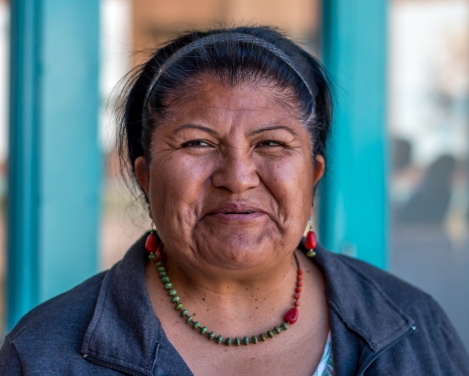The United States Congress, in 1934, made the second Monday of October a federal holiday honoring Christopher Columbus. In 2015, more cities than ever, including Seattle, Minneapolis, Portland, and Albuquerque commemorated the day with celebrations of indigenous peoples.
A recent visit from my family overlapped with Albuquerque’s first-ever “Indigenous People’s Day.” To befit the commemoration, we took advantage of my location and sought an educational experience: a visit to the Indian Pueblo Cultural Center for a retrospective exhibit about the Albuquerque Indian School (AIS). Prior to our museum visit, we were unaware of this school and its sobering history. I published an earlier blog post with photographs of artifacts in the exhibit.
After completing the exhibit we ventured to the circular museum courtyard for fresh air. Outside, under a shaded overhang near the building exit, three artists were set up with folding tables upon which they displayed their handcrafted items for sale. There was a painter of intricate animal portraits on large bird feathers, a painter of landscapes, and a clay artist.
It was at the table of the clay artist that we paused, and where I met Alice, 80/100 of my strangers.

[80/100 Strangers]: Alice
Alice makes her living by selling her authentic handmade pottery creations including: Storytellers, Happy Bowls, Seed Bowls, Kiva Pots, Canoes, Ornaments, Turtles, Papoose, and refrigerator magnets. On display were three sizes of Alice’s hand-formed clay ornaments, some three-inch sized animal figures and her detailed Storyteller piece.
In Pueblo cultures, it’s through oral history that the culture is passed from generation to generation. Storytellers are clay figurines that depict an open mouthed adult engaged in the oral tradition. The man or woman either is singing or is storytelling to any number of children who are the listeners to the storytelling. Sometimes listeners sit upon the lap of the storyteller; sometimes they surround the storyteller.
It wasn’t until after admiring her items, completing a purchase, and engaging her in conversation about her creative process that I dared to ask permission to photograph Alice for my 100 Stranger project. Having done business together it was harder for her to refuse me. She confirmed that she would have considered me rude if I were to have first photographed her without permission. It happens to her in Santa Fe when she is selling her work under the arcade off the central plaza.
Before I photographed Alice and her artwork, I explained that I would share with her all the photos and she could do whatever she wished with the images once they were downloaded. Alice was very appreciative for a chance to have her artwork exposed to a large audience. She removed her red-rimmed eyeglasses before allowing me to begin.
I let her look at the images on the back of my camera before I considered us finished. I wanted to make sure there was at least one image of herself that she liked. She responded kindly by saying they were all wonderful, but her favorite was this expressive portrait.
Alice is too young to have attended the AIS before its closure, but one of her older brothers was enrolled there; although he didn’t graduate. Alice comes from a large family with most still residing full-time in Jemez. Recently she moved into Albuquerque proper because life in the city offers many nearby conveniences: supermarkets, friends, and freeway access to other places in the state (like Santa Fe’s central plaza, and in Farmington) where she sells her pottery artwork. When Alice returns to her pueblo, despite the distance being less than 50 miles from the big city, the car ride can exceed three hours depending on local traffic and mountain road conditions. As soon as Alice arrives home, family members clamber to visit with her because she is friendly, welcoming and herself a good storyteller.
Alice explained that she forms and then air-dries her individual clay pieces. When she has made a lot of objects she builds a fire outside in which she bakes the clay. Once the pieces have cooled off, she uses acrylic paints to add the colorful ornamentation. Alice told me that on her pieces, “the lines represent longevity and the steps are symbols that represent the steps of life that lead the way to success.”

I am glad that the States finally have started to commemorate indigenous people of the country—at least in some parts. Thanks for sharing the story of Alice Celo.
LikeLiked by 1 person
I appreciate the time you spent meeting Alice with me. Thank you for the comment!
LikeLiked by 1 person